HIDDEN IN PLAIN SIGHT
Chef Wandile Mabaso, a Jozi food hero shining in the shadows
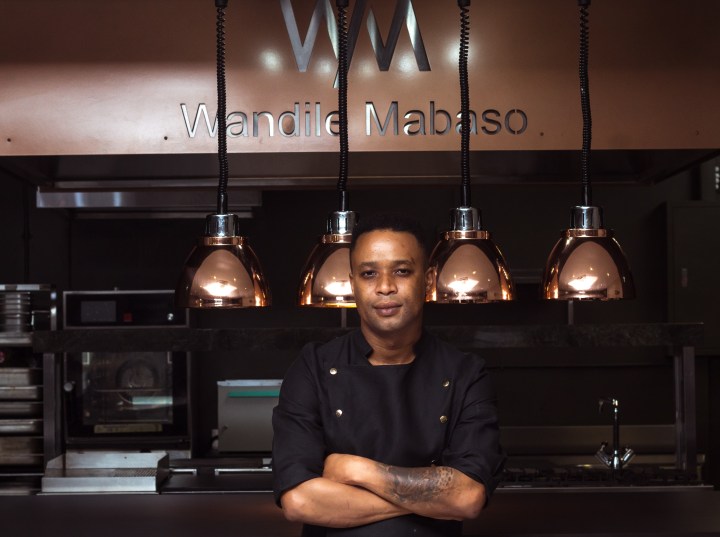
The curious case of a South African chef who touched the stars of the culinary universe, tasted the topmost cherry in Paris – and came home to stony silence.
It seems strange that homecoming chef Wandile Mabaso has not been much honoured in his own country. You’d think the name of such a chef would be on everyone’s lips. He has, in the four years he’s been home, made a mens’ magazine cover and other local magazine pieces. But we’re talking about a chef who worked his way up in the food world against scary odds, finally won through in New York and eventually received top-echelon recognition in France. You’d especially think his name would be on the lips of other South African chefs and of those in the real food know here.
Chef Wandile Mabaso has done it all, though he says he still has to do much here in South Africa. His is an extraordinary story of impatience and patience, application and creativity, mostly in both the States and France. Though it is odd that Mabaso is not lauded as a food hero in his own country, he wants to and is creating further chef heroes, as he was tutored.
It’s not as though Chef Wandile Mabaso has physically vanished here or is really invisible. But in some ways it seems like that. I wander around his Bryanston restaurant, Les Creatifs, a sleek kitchen at one end of the dining room, busy there, but the whole room open and easy to see at an empty hour like this. In the only private corner, dominated by a wall-size painting, are two velvet-covered Paris-café chairs and a small round table on which is what I take to be a big leather visitors’ book. I open it and see it’s Larousse Gastronomique, rather more lovely than my tatty old one. I look around for chef Wandile Mabaso.
So why is this chef’s profile not tip-top here in South Africa? He’s regarded as outstanding in New York food circles but especially those of Michelin France. He’s highly successful as judged there on paper and on plate and yet… how is it that he’s not much spoken of, rated and compared, as are our other South African greatermost chefs, many of whom have nothing like his accreditations. It’s something of a paradox. Or does Wandile Mabaso just keep shy of fame?
Chef Wandile answers it with a Gallic shrug and a semi-smile, saying it is not his prime concern, that his Bryanston restaurant, Les Creatifs, is full of appreciative diners every evening and that he is always busy with creative cuisine plans and ideas for the future. If there’s any sadness, he hides it well.
I’m having what were going to be a few dishes but these seem to be burgeoning into a full tasting meal, much like Chef Wandile presents to his fine dinners. They represent stories and the first dish is about to arrive after the breads and olive butter plate before me. His food, like Julian Short’s Sin + Tax’s mixed drinks (in Parkwood), will tell about places he’s been, his life of food discovery.
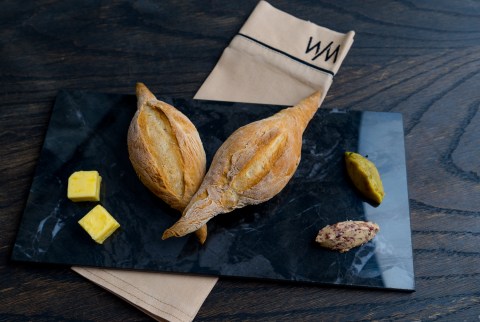
Two of the very-mini baguettes, fresh from the oven, also presented with some olive butter among more butters. (Photo: Supplied)
He’s chosen from his menu what I’ll eat and I rather like that. I was almost silly enough to pass up the bread, a crisp very-mini freshly baked baguette and a downsized springy dombola in a ring shape. Also, there are dishes I’d probably not have ordered, left to my own choices, like his oyster dish.
In any case I’d never have imagined a dish like this. Even though it’s called Oyster Ceviche Salad, one of three first courses on this week’s menu, I’d have thought about plated oysters and would rather have elected to have something actually created by the chef. How wrong I’d have been.
Corn kernels sautéed in butter, kitchen-pickled fish (a nod to Cape Malay influences in South Africa), in this case salmon, tender black beans, separate confits of lemon and ginger, are nested with baby herbs. It’s a multi-sensory experience that’s a bit Mediterranean, a bit South African, and as buttery as the couple of oysters enclosed. They’re from Langebaan, farmed. Mabaso is insistent about sourcing directly from trusted fish and shellfish suppliers that he’s discovered himself.
Wandile cooked at home as a child, more as a matter of necessity, but his mother didn’t want him doing it as a career so he went to culinary school for hotel management. However, he got an opportunity to intern as part of the catering for 300 people on a ship based in Venice in those days.
Wandile spent nine months among mostly Italian chefs, skirting the Mediterranean and western Europe, the Baltic countries. It was an eye-widening crash course in food and life, working like a demon in the kitchens. Venice, particularly, is good for seafood, as I know from the astonishing market where you have to wade around in wellies because it’s sunk a bit.
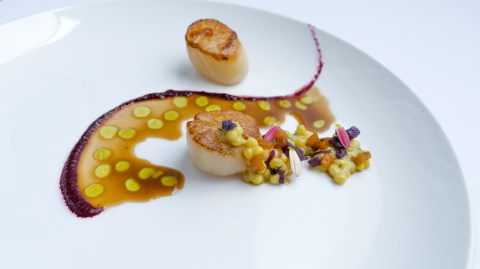
‘I get my scallops from the Eastern Cape.’ And then… (Photo: Supplied)
The second courses on this menu are also just three and I know I would have picked eight-hour cooked goat curry but I’m having scallops, which is Chef’s choice for me. “They’re smaller in South Africa. I get mine from the Eastern Cape.” What look like tiny bits of popcorn are alfalfa seeds, popped, drifting over so-called Israeli couscous, the somehow-tastier, bigger one that I’ve been eating a lot lately, and charcoal-smoked chicken liver, a rosemary and beetroot purée, the kitchen’s apricot chutney, another nod to the South African idea of apricot and fish, a little poached rhubarb and a jus that’s a nice multicultural mix of soy, melted butter and lemon. Altogether, a French and South African sour and savoury, mingled with beetroot sweetness and that scallop sweetness, with herby hits.
He took leave of the boat, returned to South Africa, enrolled at Capsicum in Lonehill for a culinary degree, doing pastry. “I was always drawing and painting and I likened that to patisserie at the time.” His love for Picasso has endured way past his pastry days and Chef Wandile has a range of plates now that he’s had made that are very Picasso-Chagall with a perfect swirl shape for food placing.
But meantime, after Capsicum, he managed to get to Miami. “I was cheap labour for the place but it was an opportunity.” He worked 20 metres from the beach but he was impatient. Wandile had planned to learn from the greats in New York somehow but Miami was more available. “I’d already seen what was possible in Italy and I wanted to learn more and More.”
“Were you not a patient person?”, I ask, considering that Chef Wandile Mabaso seems studiedly calm, almost inscrutable by comparison, these days.
He glances at me and says, “Wait,” with another half-smile.
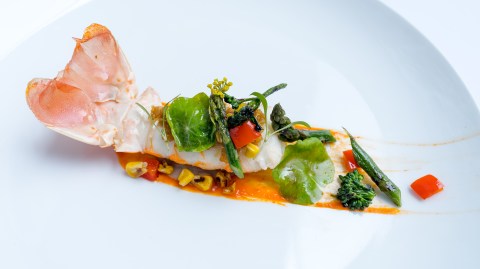
There’s an edge of the Caribbean here. The African edge of it, with that French culinary nous. (Photo: Supplied)
Before we get to a main course on his menu, again a choice of three, Mabaso presents me with another first course to taste. Lobster. He gets our rock lobster from his contact fisherman in Maputo.
It’s quickly grilled with fresh paprika, quinoa cooked in a broth with citrus and lobster jus, served with some “African plantain”, also charred asparagus and broccolini, plus a litchi and mint chutney. There’s an edge of the Caribbean here, the African edge of it.
Impatient for more knowledge, more involvement, Wandile discovered his goal, New York was hell. The restaurant industry and the kitchens are infamous for it.
“It was a very scary city.” He found himself in a cheap room for tourists, among seven men and the odd girlfriend, in bunk beds, and every morning he’d take his wish list and knock on restaurant doors. He had a week’s money and accommodation. He was made to feel like American scum. Somehow, with his pastry knowledge, he got a place at Sfoglia.
“I wasn’t focused.” It was no good. He moved. Then he found a place to rent in Harlem. “I could cook for myself there and felt like a human being.” With that hopefulness, he got cooking jobs, meeting all the kitchen immigrants of the world and endured racism even from them. He got into Gascogne, where there was hardly any English at all. He was there a year. “I was lucky – I made my way up the rungs but it was very tough. Hardcore. In New York I regularly got both verbal and physical abuse.”
And there was Julien, “With arms like this! Red hair and blue eyes. Scars. But I learned the French ingredients, the French terms, the regional techniques.” Though Mabaso was becoming pickier, he even found himself cooking Korean-French, Japanese-French. He’d been working slave shifts and still not earning enough to afford a beer after his rent, but started to earn better money and learn eastern techniques, ingredients. He even had to invent dishes. He travelled locally, to the Caribbean. Apart from Mexicans, he’d worked with so many Haitians and Cubans, with whom he felt he understood their culture, coming from Africa.

My main course is called Beef Wagyu, after the prized-meat cattle from Japan but this is different. (Photo: Supplied)
But though he’d enjoyed the extra money, Mabaso felt he needed more knowledge. For no salaries, he volunteered at the two-Michelin-star Le Bernardin, which specialised in seafood, and at three-star Daniel. Mabaso to me: “You ask if I am not a patient man?”
He met Charles Latour from Marseilles and Olivier Reginensi, who was above Latour in the French Maison Kayser group. He earned their and their associates’ respect and it was to repay him. At that point, Wandile Mabaso was learning that French cuisine was the very science of all cooking. “It is a real science. This causes that reaction and if you do this, the result will be that if you do this correctly. I had touched the key to creating food.” Chef Wandile’s main course choice for me is Beef Wagyu. I seldom order it because of my reservations about eating this very specialist and expensive Japanese meat in South Africa. This is different. It comes from the Midlands and is a cross of the Wagyu and our own Nguni. It is Wagyuni. It is deglazed with a South African cognac, peppered and served with a black and white lentil ragout, a potato purée made the way he learned from Julien in New York, where the potato is roasted, quickly disembowelled and the flesh fast-whipped before it becomes gluey. Here is charred apple, baby carrot and rainbow radishes. Here is happiness.
He will not have to choose a dessert for me because there is just one per week’s menu.
In New York, Mabaso soon found himself ensconced within the Maison Kayser group, the executive sous chef. Over his two and a half years with them, they opened seven restaurants.
The New York Frenchmen of the Maison Kayser group were also preparing him for France. They sent him to the French Culinary Institute in the States for more classical training and he was introduced to Monégasque Alain Ducasse, world famous, pioneering French chef, then of but seventeen Michelin stars for his own restaurants.
Wandile was to go to France when the Paris attacks happened in 2015 and the borders closed. It seemed ages in the delay but in due time he was one of the chefs inside Le Meurice, Ducasse’s possibly most celebrated restaurant in the oldest palace in Paris, cooking for the world’s statesmen and stars.
“Ducasse used to move me around a lot, also to the Plaza Athénée. He had 40 restaurants. The pressure for the Michelin stars is incredible and we won well with them. All the knowledge with all the service perfection is one thing but I was taught to use myself, my labour as the final tool, to create the genius.
“My philosophy and, as we said, every Frenchman has one and asks what is yours, is to labour and put in gratitude in its humblest form.” Yes, real humility is the key. It must have been difficult to muster humility as a Ducasse chef, I venture.
In Paris in 2017, “I was given the highest award that exists for a chef in France, the Culinary Excellence of the College de France.” (Not a school or college or university he attended but the excellence award made by the French government.)
“I have won much with the Ducasse team and I have personally felt the weight of those Michelin stars on my shoulders. But I preferred then and still prefer to do it the hard way. I am not yet at the height of my career.”
Chef Wandile Mabaso’s food speaks for itself. In South Africa he wants to encourage black chefs to rise through the ranks in a good way, to use themselves.
His pastry chef, one such protegé, a giant of a man who was a graphic artist in advertising, is Kenosi Malebye. The Les Creatifs team have discovered that I adore figs and, on my plate of Amarula crème, chantilly vanilla, a chocolate sponge and passion fruit parfait on pistachio crumble, is a quarter of a fig, admittedly out of season, but as a present.
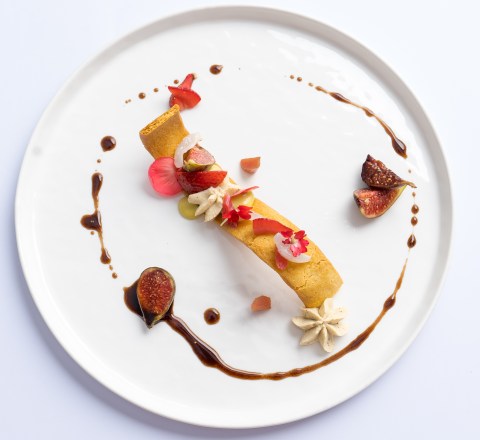
Not as my dessert was presented or consisted entirely but another by chef Kenosi Malebye. (Photo: Supplied)
A few days later I will call some of our topmost chefs to ask why chef Wandile Mabaso’s name is not on their lips, why he’s not especially recognised in his own country as being among them. One chef will say that French cuisine is not respected in South Africa. He hasn’t eaten at Les Creatifs yet so doesn’t know that the methods may be French but that Mabaso is moving the ingredients more and more to South African ones. Another chef will say it’s difficult working for oneself when one has had the protection of Ducasse. The others will say they are a bit busy or that they don’t know him well enough to comment.
Chef Wandile Mabaso’s food tells me everything that people, maybe even his peers as chefs, may not be saying.
I can’t use words for it like “excellent” or “best” because suddenly they’re no longer relevant or good enough. I’m realising why people save up to eat at those top French restaurants. I’ve only ever eaten charming country food, patisserie and boulangerie in France. I have simply had no idea of this mastery of taste. It’s way out of any of the leagues I know. But at the end of the meal, he and I try out some pressed ginger with gin as he plays with a cocktail idea. I don’t tell him about the elephantini my sister and I invented with similar ingredients. And I shan’t tell him what the other chefs will or won’t say. DM/TGIFood
Les Creatifs, shop 12H Hobart Grove, Hobart Road, Bryanston. 068 182 7929
Follow Marie-Lais Emond on Instagram Marie-Lais Emond.
The writer supports Nosh Food Rescue, an NGO that helps Jozi feeding schemes with food ‘rescued’ from the food chain. Please support them here.




 Become an Insider
Become an Insider
Marvellous story, thanks so much. Inspirational. Not only good food, but healthy food by the sounds of it; that’s why he won’t fit in SA. We are South Africans and we love junk food, boerewors and pap and have little time for cuisine; nor can we afford it. Rapidly becoming a very poor country and can’t find the rands for food lovers like Wandile Mabaso.